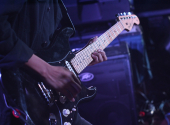
Practice With a Metronome: Don’t Cry, We Brought This on Ourselves
What should be one of the first things a budding musician gets? A metronome. It's simple. This basic tool is as essential to musical development as the instrument the musician practices on. In fact, practicing with a "click" has far more dimensions than just keeping time. It will help you improve your technique, clean up your playing, anchor your playing in time so you can play with other musicians, and help you understand why and how the songs by your favorite artists work. And all this is accomplished by something you don't even need to buy, store, or carry—a metronome can be downloaded as a free app on your phone.
The metronome is a magical thing that any responsible teacher should introduce to their students. Because anyone who doesn't practice with a metronome is selling themselves short. Without rhythm, without groove, playing a musical instrument is nothing but a form of athletics. The fingers run over the strings and frets, the hands and mallets over the membranes, pads, and cymbals—but if they are not in rhythm, it is a completely empty exercise. The metronome should be part of any exercise. Whether you're practicing scales, learning a song, or putting together a solo. Below you'll find a few reasons why a metronome should be part of every aspiring musician's kit, even for singers.
It improves your inner clock
Not only does the metronome support the musician while playing, practicing with the metronome helps strengthen their internal clock. Obviously this is not referring to some reproductive function, but the ability to keep time without a metronome. The best way to develop your internal clock is to gradually divide your BPM (beats per minute). For example, start playing at a tempo of 160 BPM, then go to 80 and try playing at the same tempo, with the metronome clicking on the 1st and 3rd beat, and then with the metronome clicking on the 2nd and 4th beat. The more adventurous musicians can eventually go to 40 BPM and shift that one click in the measure to different beats.
It's a mirror that never lies
When you learn a song, it usually has passages in which you subconsciously speed up and passages in which you slow down. The metronome is able to point out these differences. There can be a number of reasons behind a tempo change. It may be feeling, or it may be that the passages are of varying difficulty, and it is common to fall slightly behind in the more difficult ones when learning. But unless the playing is consistent and flows without noticeable jerks in tempo, can you truly say you're able to play that piece? That's why it's essential to practice in tempo, with a metronome. For example, it is possible to practice more difficult passages at a gradually increasing tempo, which helps to make the playing more precise.
It helps you play with more precision
Start practicing the problematic passage at a slower pace. For example, if you play a solo at 180 BPM, slow it down to 140 and gradually build up. But don't stop at 180, proceed calmly to 200 BPM. This will help you feel more comfortable when you then return to your original speed. Musicians have been using this old trick forever. To sum it up in one short sentence: "Start slow and build up gradually." But with a metronome, it takes on more precise contours. Because, again, it's not important to play individual notes or beats mechanically. "A lot of musicians don't even realize that people will listen to them one day and their playing has to do something with the audience," Eduard Stepanek, drummer of Abraxas and #Černá, puts it succinctly. That's why it's very important to pay attention to the precision of playing already in a slow tempo when you are just learning a given passage.
Without light, there would be no darkness
The cliché in this paragraph title refers to the metronome's function. The clicking of the metronome leaves precisely spaced out dashes in between. What happens in these dashes is just as important as what happens on "1, 2, 3, 4." It's a space that kind of highlights the errors, so it's good to think about it. Common mistakes—not just with guitarists—are all sorts of blips and clanks at the very moments when they can be heard so well. The second such service is performed by the metronome when building a solo. Some musicians claim that a good solo resembles singing. And no one can sing without taking a breath. Similarly, a solo should have places where the musician "takes a breath" for the next passage.
(Beautiful proof that a solo is like a vocal line)
No evidence has yet been found to confirm that sleeping with a metronome somehow improves rhythm perception. It probably can't hurt—in fact, there is supposedly research that claims that having a metronome on while sleeping improves the ability to remember things learned during the day. But there's simply no substitute for practicing with a metronome. Shortcuts don't work, and those who want to achieve something simply have to sacrifice something. Just ask any top athlete.
If you have found an error or typo in the article, please let us know by e-mail info@insounder.org.


